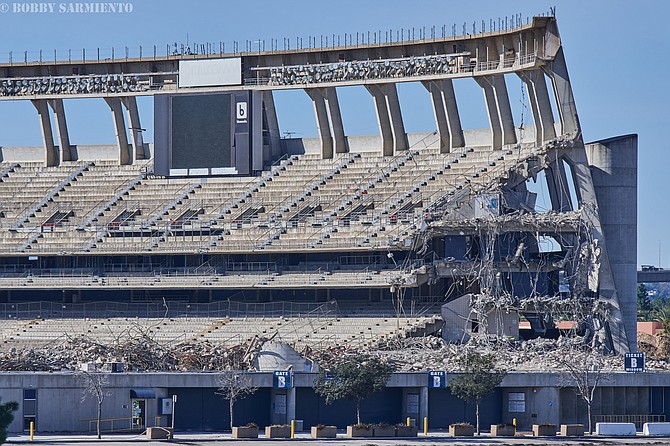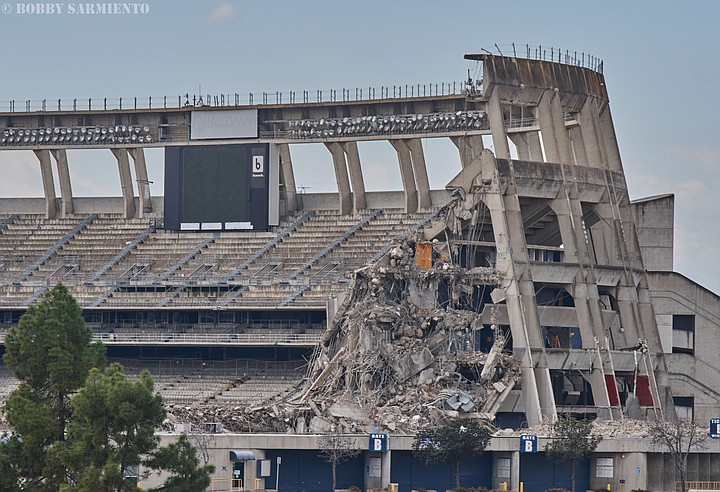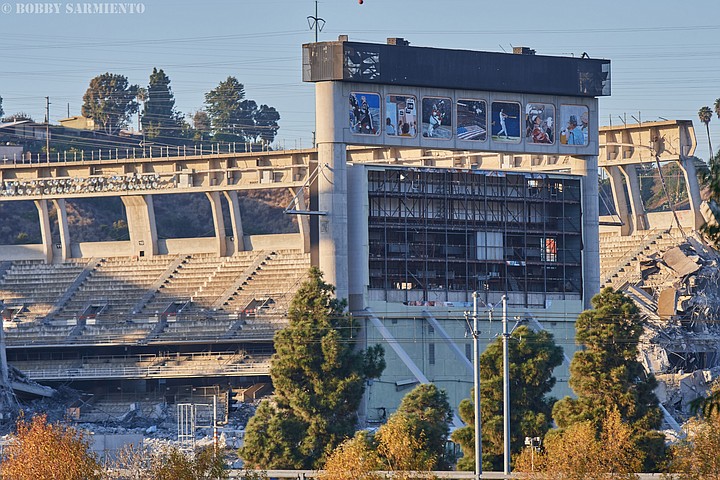 Facebook
Facebook
 X
X
 Instagram
Instagram
 TikTok
TikTok
 Youtube
Youtube


I saw my first rock concert in 1987 — U2 played the Carrier Dome in Syracuse as part of their tour for The Joshua Tree. Time magazine put them on the freaking cover, with the cutline “Rock’s Hottest Ticket” — and I got one. Well, two: I was 14; my mother insisted on chaperoning. While 50,000 fans stood and swayed to “Where the Streets Have No Name,” she sat perfectly still, earplugs firmly in place, content in the certainty that her son was getting high on the music and nothing else. Remember U2? Remember Time magazine? I mean, technically, they’re both still around, but of late, it seems like all I can see are a lot of fins to a lot of siècles.
Talking of which: I saw my last rock concert in 2017 — U2 played San Diego County Credit Union Stadium (formerly Qualcomm Stadium, formerly Jack Murphy Stadium, formerly San Diego Stadium) as part of their 30th anniversary tour for The Joshua Tree. I knew it would be my last show well before it was over, because I found myself taking notes during the performance. When Dionysus can’t manage to get ahold of you despite the company of 70,000 fellow pilgrims, the finest in thunderous noise and flashing lights, and three decades’ worth of pop nostalgia, it’s time to stay home.

Talking of which: a few Sundays back, I met photographer Bobby Sarmiento as he shot the half-demolished stadium from the bridge over the 15 on San Diego Mission Road. He was one of three working the spot, and he agreed to chat a few days later. “I’d been there two weeks before you saw me,” he said, “photographing from the southeast side. And I went the next week as well; they had gotten a lot done, despite the rain. But I wasn’t there just because, ‘Ooh, they’re tearing it apart.’ I was trying to capture a mood. It’s nostalgic for me. I met some really good people while I was shooting. There was a woman in her early fifties with her mother, who I believe was in her eighties. I thought it was really nice, because her mom had taken her to the stadium for thirty-plus years, a lot of events, and they had a lot of memories of the place. It was sad for them to see it go down, but they really enjoyed being there. I took the pictures for them as well as myself, because I remember my mom taking me there a lot. That appreciation, that feeling is what I wanted in my photographs.”

To get that feeling, Sarmiento waited for a day when the light would cooperate. “I’m old-school; I like to do full manual settings, even with my lens apertures and focus. And I’ll edit photos for customers, but for myself, I like to focus on natural light. I look at photography like art, and I’m using natural light to paint. The day you saw me, I went because it had just rained, and we had those really nice clouds above the stadium. The week after that, I went back a second time, because fifteen minutes after I left, the sky changed. I got a couple more shots that looked much better to me.” For now, the photos — some taken with a telephoto lens, some with wide angle, some with mid-range — live on his Facebook page; he’s thinking of starting an Instagram account for the series.
Sarmiento lives in Point Loma now, but he grew up in Crown Point, and the stadium was a big part of his life. “I attended a variety of events. Of course, the Padres, and the Chargers, and the San Diego Sockers when they played there. They even held a camp there for kids that I went to, and so I actually played there a couple of times in the early ’80s. A variety of musical concerts: Metallica, Guns N’ Roses, The Rolling Stones… the last one was Pink Floyd in the late ’90s. Besides that, there was super cross; I didn’t go to the monster truck events. But outside the stadium in the lot, they had car shows and other cultural events, and I went to those.” Of such moments are memories made, and of such memories, a life.
I got to see the Padres play against the Braves at the stadium during the 1998 National League Championship Series — the improbable playoff run that helped bamboozle San Diego into voting to fund Petco Park before the team spiraled into five straight losing seasons and a decade-plus playoff drought. And 1998 was the year the stadium hosted its first Super Bowl following the city’s decision to spend millions on upgrades that would make it a viable venue. We got one more Big Game after that in 2003; all those improvements are rubble now. I attended a Chargers game, too, back in 2009, and had the good fortune to meet the Silva family, fans since the team’s first season in 1960. Alfred Silva had been buried the year previous in a powder blue and gold coffin, his body clad in a Chargers hat, Chargers shoes, and a Lance Alworth jersey. “It was awesome,” recalled Alfred’s son Armando. “He was ready to go up and watch some more football.” That day, Armando was there with his mother and cousins, all dressed in their jerseys. Now, of course, the Chargers are gone, despite the Silva family fandom. Another siècle, another fin.
Vanity Fair magazine once asked a number of writers to come up with their own epitaphs; the most famous reply is Dorothy Parker’s “Excuse my dust.” Of late, I’ve been thinking mine should read, “It all seemed so important at the time.” The Chargers, the Padres, the public funds for private enterprises, the talk of how a “world-class city” absolutely needed to have pro sports — it all seemed so important. Then again, given Sarmiento’s meeting with that woman and her mother, maybe some of it was.



I saw my first rock concert in 1987 — U2 played the Carrier Dome in Syracuse as part of their tour for The Joshua Tree. Time magazine put them on the freaking cover, with the cutline “Rock’s Hottest Ticket” — and I got one. Well, two: I was 14; my mother insisted on chaperoning. While 50,000 fans stood and swayed to “Where the Streets Have No Name,” she sat perfectly still, earplugs firmly in place, content in the certainty that her son was getting high on the music and nothing else. Remember U2? Remember Time magazine? I mean, technically, they’re both still around, but of late, it seems like all I can see are a lot of fins to a lot of siècles.
Talking of which: I saw my last rock concert in 2017 — U2 played San Diego County Credit Union Stadium (formerly Qualcomm Stadium, formerly Jack Murphy Stadium, formerly San Diego Stadium) as part of their 30th anniversary tour for The Joshua Tree. I knew it would be my last show well before it was over, because I found myself taking notes during the performance. When Dionysus can’t manage to get ahold of you despite the company of 70,000 fellow pilgrims, the finest in thunderous noise and flashing lights, and three decades’ worth of pop nostalgia, it’s time to stay home.

Talking of which: a few Sundays back, I met photographer Bobby Sarmiento as he shot the half-demolished stadium from the bridge over the 15 on San Diego Mission Road. He was one of three working the spot, and he agreed to chat a few days later. “I’d been there two weeks before you saw me,” he said, “photographing from the southeast side. And I went the next week as well; they had gotten a lot done, despite the rain. But I wasn’t there just because, ‘Ooh, they’re tearing it apart.’ I was trying to capture a mood. It’s nostalgic for me. I met some really good people while I was shooting. There was a woman in her early fifties with her mother, who I believe was in her eighties. I thought it was really nice, because her mom had taken her to the stadium for thirty-plus years, a lot of events, and they had a lot of memories of the place. It was sad for them to see it go down, but they really enjoyed being there. I took the pictures for them as well as myself, because I remember my mom taking me there a lot. That appreciation, that feeling is what I wanted in my photographs.”

To get that feeling, Sarmiento waited for a day when the light would cooperate. “I’m old-school; I like to do full manual settings, even with my lens apertures and focus. And I’ll edit photos for customers, but for myself, I like to focus on natural light. I look at photography like art, and I’m using natural light to paint. The day you saw me, I went because it had just rained, and we had those really nice clouds above the stadium. The week after that, I went back a second time, because fifteen minutes after I left, the sky changed. I got a couple more shots that looked much better to me.” For now, the photos — some taken with a telephoto lens, some with wide angle, some with mid-range — live on his Facebook page; he’s thinking of starting an Instagram account for the series.
Sarmiento lives in Point Loma now, but he grew up in Crown Point, and the stadium was a big part of his life. “I attended a variety of events. Of course, the Padres, and the Chargers, and the San Diego Sockers when they played there. They even held a camp there for kids that I went to, and so I actually played there a couple of times in the early ’80s. A variety of musical concerts: Metallica, Guns N’ Roses, The Rolling Stones… the last one was Pink Floyd in the late ’90s. Besides that, there was super cross; I didn’t go to the monster truck events. But outside the stadium in the lot, they had car shows and other cultural events, and I went to those.” Of such moments are memories made, and of such memories, a life.
I got to see the Padres play against the Braves at the stadium during the 1998 National League Championship Series — the improbable playoff run that helped bamboozle San Diego into voting to fund Petco Park before the team spiraled into five straight losing seasons and a decade-plus playoff drought. And 1998 was the year the stadium hosted its first Super Bowl following the city’s decision to spend millions on upgrades that would make it a viable venue. We got one more Big Game after that in 2003; all those improvements are rubble now. I attended a Chargers game, too, back in 2009, and had the good fortune to meet the Silva family, fans since the team’s first season in 1960. Alfred Silva had been buried the year previous in a powder blue and gold coffin, his body clad in a Chargers hat, Chargers shoes, and a Lance Alworth jersey. “It was awesome,” recalled Alfred’s son Armando. “He was ready to go up and watch some more football.” That day, Armando was there with his mother and cousins, all dressed in their jerseys. Now, of course, the Chargers are gone, despite the Silva family fandom. Another siècle, another fin.
Vanity Fair magazine once asked a number of writers to come up with their own epitaphs; the most famous reply is Dorothy Parker’s “Excuse my dust.” Of late, I’ve been thinking mine should read, “It all seemed so important at the time.” The Chargers, the Padres, the public funds for private enterprises, the talk of how a “world-class city” absolutely needed to have pro sports — it all seemed so important. Then again, given Sarmiento’s meeting with that woman and her mother, maybe some of it was.
Comments